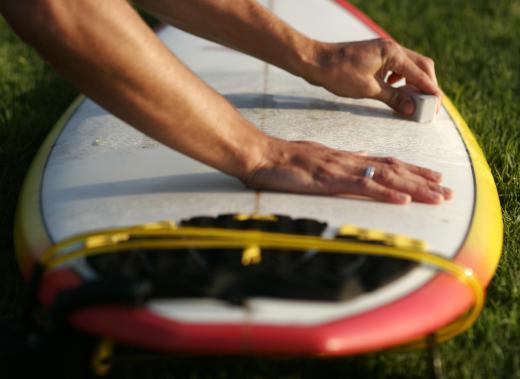At Sports&Hobbies, we're committed to delivering accurate, trustworthy information. Our expert-authored content is rigorously fact-checked and sourced from credible authorities. Discover how we uphold the highest standards in providing you with reliable knowledge.
What are the Best Tips for Surfing for Beginners?
Some of the best tips for surfing for beginners revolve around acquiring basic skills and necessary equipment. Correct paddling, sitting, and standing techniques are also key concepts in surfing for beginners. Being alert and maintaining correct, though relaxed, posture are skills a beginning surfer should strive to do, too. Another suggestion is to avoid surfing alone, and to consider taking a few lessons.
Prior to surfing for fun, a new surfer should first be comfortable with the water and swimming in general. Surfing lessons, usually from a professional surfing instructor, are recommended as the best introduction to surfing for beginners. Surfers should be sure to assemble all of their necessary equipment before beginning. This typically includes a long surfboard made from foam, designed for beginners. A wetsuit and surfboard leash are also considered key surfing equipment.

Beginning surfers may wish to borrow their gear rather than purchase it. This will prevent new surfers from spending money on costly equipment that they may not utilize frequently. A wetsuit, surfboard, and other types of surfing accessories can be rented or borrowed from a friend. Another benefit of renting a surfboard is that rental companies typically wax boards before renting them out, saving renters from having to do so.

Small, slow waves are ideal in surfing for beginners. New surfers should always surf with at least one experienced surfer. They should practice getting up from a prone to a standing position, called "popup" in surfing lingo, on land before trying this in the water. A surfing instructor can teach the proper way to do a popup. Feet should always be parallel to the surfboard stringer, the thin line of wood that extends down the center of the board, while making this single, smooth movement.

Riding a surfboard on one's belly, or belly-prone, is the first step to surfing. When carrying the board into the waves, surfers should always stay to the side of the board to prevent getting hurt. While some wobbling is normal for beginning surfers, they should continue doing this until they are comfortable on the board. When surfing on one's stomach, while sitting, or standing, one should always remain as calm and relaxed as possible to maintain balance.
When paddling the surfboard, arms should be used in alternative strokes. Many beginners make the mistake of paddling with both arms at once, which will cause the board to travel at an inconsistent speed. Previous popup practice on land should help new surfers stand up more easily on the board. When the surfer's arms extend, they should be kept at a slightly higher level than the surfer's waist.
Looking at one's feet while standing on the board, however, is not advised, as it usually prompts surfers to lose their balance. Instead, surfers should keep their gaze focused forward or upward. Practicing these stances and movements on a board that is on sand, or even on a higher surface, such as a bed, can help a new surfer become more comfortable with these techniques.
AS FEATURED ON:
AS FEATURED ON:













Discuss this Article
Post your comments